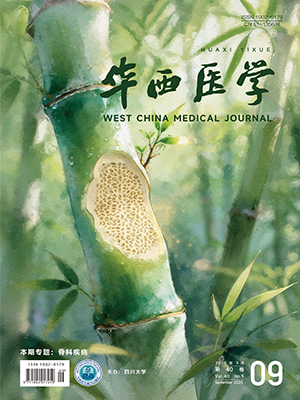| 1. |
The Lancet. Diabetes: a defining disease of the 21st century. Lancet, 2023, 401(10394): 2087.
|
| 2. |
Redondo MJ, Hagopian WA, Oram R, et al. The clinical consequences of heterogeneity within and between different diabetes types. Diabetologia, 2020, 63(10): 2040-2048.
|
| 3. |
González-Saldivar G, Millan-Alanis JM, González-González JG, et al. Treatment burden and perceptions of glucose-lowering therapy among people living with diabetes. Prim Care Diabetes, 2022, 16(4): 568-573.
|
| 4. |
Vijan S, Hayward RA, Ronis DL, et al. Brief report: the burden of diabetes therapy: implications for the design of effective patient-centered treatment regimens. J Gen Intern Med, 2005, 20(5): 479-482.
|
| 5. |
楊志鵬, 王皓翔, 歐文森, 等. 基于 Ordinal Logistic 回歸分析的慢性非傳染性疾病患者治療負擔的現狀研究. 中國全科醫學, 2019, 22(5): 559-563.
|
| 6. |
Herzig L, Zeller A, Pasquier J, et al. Factors associated with patients’ and GPs’ assessment of the burden of treatment in multimorbid patients: a cross-sectional study in primary care. BMC Fam Pract, 2019, 20(1): 88.
|
| 7. |
Leppin AL, Gionfriddo MR, Kessler M, et al. Preventing 30-day hospital readmissions: a systematic review and meta-analysis of randomized trials. JAMA Intern Med, 2014, 174(7): 1095-1107.
|
| 8. |
趙瑩, 王晨, 孫玉倩, 等. 住院老年慢性病病人治療負擔現狀及其影響因素研究. 現代預防醫學, 2022, 49(6): 1078-1081, 1117.
|
| 9. |
Sav A, King MA, Whitty JA, et al. Burden of treatment for chronic illness: a concept analysis and review of the literature. Health Expect, 2015, 18(3): 312-324.
|
| 10. |
Brod M, Hammer M, Christensen T, et al. Understanding and assessing the impact of treatment in diabetes: the treatment-related impact measures for diabetes and devices (TRIM-diabetes and TRIM-diabetes device). Health Qual Life Outcomes, 2009, 7: 83.
|
| 11. |
Ishii H, Shin H, Tosaki T, et al. Reproducibility and validity of a questionnaire measuring treatment burden on patients with type 2 diabetes: diabetic treatment burden questionnaire (DTBQ). Diabetes Ther, 2018, 9(3): 1001-1019.
|
| 12. |
Spencer-Bonilla G, Serrano V, Gao C, et al. Patient work and treatment burden in type 2 diabetes: a mixed-methods study. Mayo Clin Proc Innov Qual Outcomes, 2021, 5(2): 359-367.
|
| 13. |
Serrano V, Spencer-Bonilla G, Boehmer KR, et al. Minimally disruptive medicine for patients with diabetes. Curr Diab Rep, 2017, 17(11): 104.
|
| 14. |
Lin K, Yao M, Andrew L, et al. Exploring treatment burden in people with type 2 diabetes mellitus: a thematic analysis in china’s primary care settings. BMC Primary Care, 2024, 25(1): 88.
|
| 15. |
Shippee ND, Shah ND, May CR, et al. Cumulative complexity: a functional, patient-centered model of patient complexity can improve research and practice. J Clin Epidemiol, 2012, 65(10): 1041-1051.
|
| 16. |
Lin PJ, Kent DM, Winn A, et al. Multiple chronic conditions in type 2 diabetes mellitus: prevalence and consequences. Am J Manag Care, 2015, 21(1): e23-e34.
|
| 17. |
Fishman SR, Fernandez Galvis MA, Linnell J, et al. Diabetes-related quality of life: learning from individuals making lifestyle changes to improve type 2 diabetes control. Sci Diabetes Self Manag Care, 2023, 49(2): 136-149.
|
| 18. |
Ellahham S. Artificial intelligence: the future for diabetes care. Am J Med, 2020, 133(8): 895-900.
|
| 19. |
Grunberger G, Sherr J, Allende M, et al. American association of clinical endocrinology clinical practice guideline: the use of advanced technology in the management of persons with diabetes mellitus. Endocr Pract, 2021, 27(6): 505-537.
|
| 20. |
戴煒, 關陽, 李韻, 等. 基于動態血糖監測的糖尿病遠程管理系統設計. 醫療衛生裝備, 2023, 44(09): 42-48.
|
| 21. |
Veatch RM. Models for ethical medicine in a revolutionary age. What physician-patient roles foster the most ethical realtionship?. Hastings Cent Rep, 1972, 2(3): 5-7.
|
| 22. |
Pilla SJ, Jalalzai R, Tang O, et al. A national survey of physicians’ views on the importance and implementation of deintensifying diabetes medications. J Gen Intern Med, 2023, 39(6): 992-1001.
|
| 23. |
Shay LA, Lafata JE. Where is the evidence? A systematic review of shared decision making and patient outcomes. Med Decis Making, 2015, 35(1): 114-131.
|
| 24. |
Brown A, Dornhorst A, McGowan B, et al. Low-energy total diet replacement intervention in patients with type 2 diabetes mellitus and obesity treated with insulin: a randomized trial. BMJ Open Diabetes Res Care, 2020, 8(1): e001012.
|
| 25. |
Ojo TK, Joshua OO, Ogedegbe OJ, et al. Role of intermittent fasting in the management of prediabetes and type 2 diabetes mellitus. Cureus, 2022, 14(9): e28800.
|
| 26. |
Dong C, Liu R, Huang Z, et al. Effect of exercise interventions based on family management or self-management on glycaemic control in patients with type 2 diabetes mellitus: a systematic review and meta-analysis. Diabetol Metab Syndr, 2023, 15(1): 232.
|
| 27. |
Zhao L, Xu F, Zheng X, et al. Mediation role of anxiety on social support and depression among diabetic patients in elderly caring social organizations in China during COVID-19 pandemic: a cross-sectional study. BMC Geriatr, 2023, 23(1): 790.
|
| 28. |
Schram MT, Assendelft WJJ, van Tilburg TG, et al. Social networks and type 2 diabetes: a narrative review. Diabetologia, 2021, 64(9): 1905-1916.
|
| 29. |
Boehmer KR, Gionfriddo MR, Rodriguez-Gutierrez R, et al. Patient capacity and constraints in the experience of chronic disease: a qualitative systematic review and thematic synthesis. BMC Fam Pract, 2016, 17(1): 127.
|
| 30. |
Hanlon P, Bryson I, Morrison H, et al. Self-management interventions for type 2 diabetes: systematic review protocol focusing on patient workload and capacity support. Wellcome Open Res, 2021, 6: 257.
|
| 31. |
Lin K, Yaomi, Chenzhang, et al. Conceptual framework and responding approach of treatment burden of type 2 diabetes: a video recording-based. Chinese General Practice, 2023, 26(34): 4302-4307.
|
| 32. |
Schmitt A, Gahr A, Hermanns N, et al. The Diabetes Self-Management Questionnaire (DSMQ): development and evaluation of an instrument to assess diabetes self-care activities associated with glycaemic control. Health Qual Life Outcomes, 2013, 11: 138.
|
| 33. |
李超群, 井坤娟, 劉昱瑩, 等. 糖尿病自我管理量表的漢化及信效度評價. 現代預防醫學, 2018, 45(24): 4477-4481.
|
| 34. |
Toobert DJ, Hampson SE, Glasgow RE. The summary of diabetes self-care activities measure: results from 7 studies and a revised scale. Diabetes Care, 2000, 23(7): 943-950.
|
| 35. |
李延飛, 陳偉菊, 許萬萍, 等. 2 型糖尿病患者自我管理行為量表的改良及其信效度檢驗. 現代醫院, 2011, 11(3): 148-150.
|
| 36. |
Breslin M, Mullan RJ, Montori VM. The design of a decision aid about diabetes medications for use during the consultation with patients with type 2 diabetes. Patient Educ Couns, 2008, 73(3): 465-472.
|
| 37. |
Boehmer KR, Hargraves IG, Allen SV, et al. Meaningful conversations in living with and treating chronic conditions: development of the ICAN discussion aid. BMC Health Serv Res, 2016, 16(1): 514.
|
| 38. |
Mei Y, Yang X, Li Y, et al. Validity and reliability of the chinese version of the diabetes treatment burden questionnaire (DTBQ) among patients with type 2 diabetes. Diabetes Metab Syndr Obes, 2023, 16: 663-675.
|
| 39. |
Eton DT, Yost KJ, Lai JS, et al. Development and validation of the patient experience with treatment and self-management (PETS): a patient-reported measure of treatment burden. Qual Life Res, 2017, 26(2): 489-503.
|
| 40. |
Tran VT, Montori VM, Eton DT, et al. Development and description of measurement properties of an instrument to assess treatment burden among patients with multiple chronic conditions. BMC Med, 2012, 10: 68.
|
| 41. |
林愷, 郭麗紅, 黃周紅, 等. 糖尿病自我管理量表的漢化及信效度評價. 中華全科醫學, 2022, 20(6): 974-977, 1011.
|
| 42. |
Espinoza P, Varela CA, Vargas IE, et al. The burden of treatment in people living with type 2 diabetes: a qualitative study of patients and their primary care clinicians. PloS One, 2020, 15(10): e0241485.
|
| 43. |
Gao CC, Espinoza Suarez NR, Toloza FJK, et al. Patients’ perspective about the cost of diabetes management: an analysis of online health communities. Mayo Clin Proc Innov Qual Outcomes, 2021, 5(5): 898-906.
|




